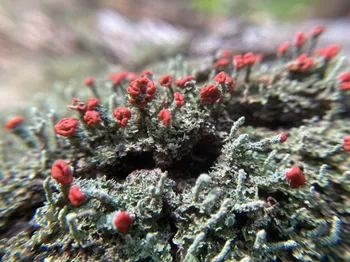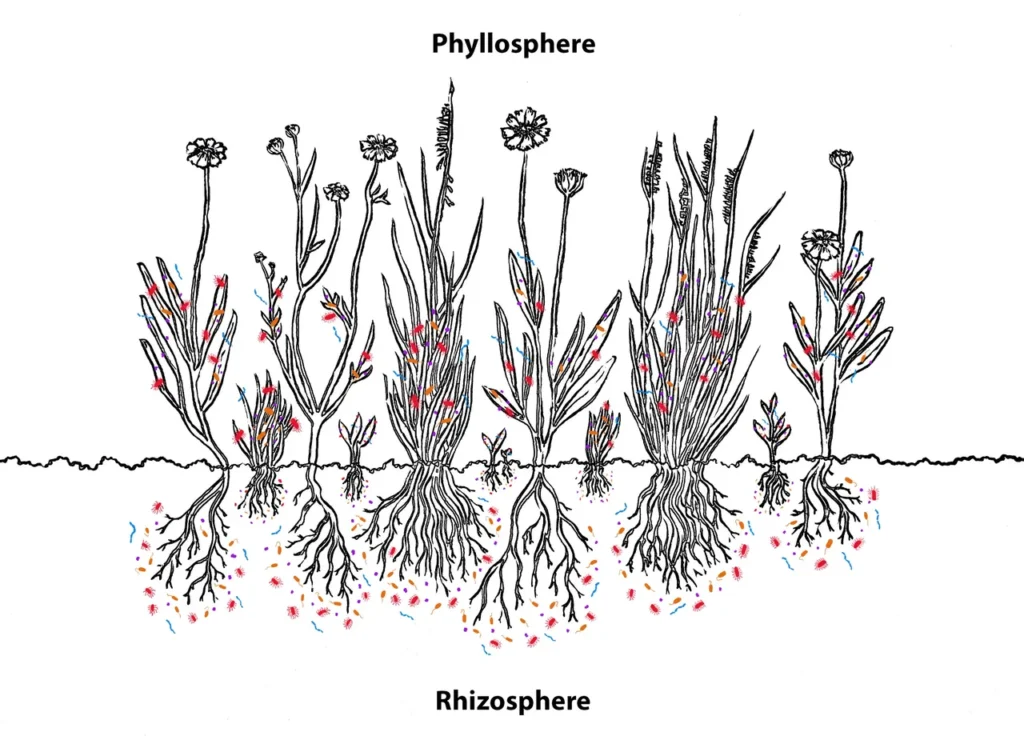
Being a Multitude: Life as a Holobiont
What does it mean to live as a holobiont, to be a multitude instead of an individual? As humans, we are a scaffold for the microorganisms living in and around us — we are more microbial than human (30 trillion human cells compared to 39 trillion bacterial). From bacteria, to forests, to humans – all living organisms have intimate relationships with their immediate neighbors and exist as a group which is larger than the sum of its parts.
The concept of a holobiont is the combined assemblage of a host multicellular organism and the many other species living on, in, and around it in a symbiotic relationship with mutual benefits. Each individual living unit is a “biont” and the collective group is a “holobiont” from the Greek word “holos” for whole. The term holobiont was first introduced in 1991 by Lynn Margulis and initially referred to a simple entity with a host and one symbiont such as a lichen which includes a fungi and an algal symbiont (see image above) and corals which include the coral animal and a photosynthetic algae called zooxanthellae (Margulis, 1991). As it turns out, neither lichens or corals have only two organisms, and the term holobiont has now expanded in meaning to include most multicellular organisms and the consortium of microbiota living with them. Microorganisms can include bacteria, viruses, archaea. protists, and microscopic fungi. What is new to the holobiont story is the fairly recent realization of the ubiquitous nature of host-associated microbes and their central role in host biology, ecology and evolution (Hasani et al, 2018).
As humans, we exist as holobionts living in a relationship with a vast consortium of microorganisms that colonize our skin and mucosal surfaces. The majority of our microbial partners live in our guts or gastrointestinal tracts, where they have been shown to play a major role in health – with effects on immunity, digestion, and mood regulation. Our Western diet and lifestyle perturbs our gut ecosystems with long-term consequences for our health including greater susceptibility to diseases such as irritable bowel syndrome, asthma, diabetes, and autism (Guchte et al, 2018). The future of medicine will rely more heavily on nutrition as well as the development of microbiota therapy.
Plants also exist as holobionts with important consequences for the function of landscapes. A critical aspect of polyculture lawns is the healthy microbiome associated with the diverse plant population. This microbiome has many important functions: supporting growth at all stages starting with germination, promoting plant resistance to biotic (pathogens) and abiotic (drought, salinity) stresses, and assisting plants with nutrient uptake. Probably the best known example of plant-microbe interactions are those between leguminous plants and rhizobia – the bacteria that colonize the root nodules of legumes and fix atmospheric nitrogen into ammonia that can be used by plants for their growth and development. There is no need for nitrogen fertilizers in a polyculture lawn! Similarly, soil microbes aid in phosphate solubulization to provide phosphorus in a usable form to plants.
The plant holobiont provides three specific habitats for microbes: the leaves and stems above the soil surface, known as the phyllosphere (plant:air interface), the roots underneath the soil surface, known as the rhizosphere (plant:soil interface), and the inside of the plant, known as the endosphere. The rhizosphere, the area adjoining the plant roots, is very rich in microbes and may be one of the ecosystems with the greatest biodiversity on our planet (Chauhan, 2023).

Where does the plant microbiome come from? Most of the microbiome components that will inhabit the plant are from vertical transmission – from seeds (Chauhan et al, 2023) – just as the human microbiome is primarily colonized from passage through the birth canal. Others are from the soil, such as the rhizobia bacteria associated with root nodules in legumes. Our polyculture seed mix contains species from many plant families to provide diversity in the co-created soil microbiome and therefore many benefits such as improved plant growth and drought-tolerance.
Climate change exerts some of its harm by disrupting the symbiotic relationships in holobionts — such as the loss of symbiotic fungi and bacteria from soil with activities that degrade soil such as much of current landscaping and agricultural practices. Similarly, warming oceans result in the loss of algal symbionts from coral reefs, resulting in coral bleaching (see photo below).

A holobiont is not a random assemblage but is highly ordered, and our bond with these microorganisms is so profound that we literally become the ecosystem where they live, while they influence our development, health and behavior. Understanding the role of the holobiont can help us to better understand the complexity of the natural world and how species can interact and depend on each other for survival. Knowing that we are not isolated individual entities but deeply connected to other life provides a fresh perspective on our connection with nature and how we think about caring for our planet.
References
Chauhan et al, 2023. Soil Microbiome: Diversity, Benefits and Interactions with Plants. Sustainability 15, 14643.
Guchte et al, 2018. Humans as Holobionts: implications for prevention and therapy. Microbiome 6, 81.
Hasani at el, 2018. Microbial Interactions within the plant holobiont. Microbiome 6:58.
Margulis, 1991. Symbiosis as a Source of Evolutionary Innovation.
Top image credit: Brian Lovett, ASM
